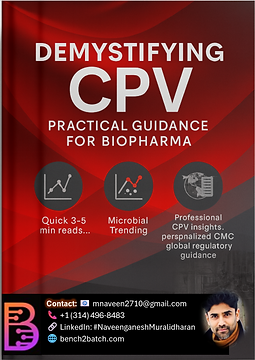Making CPV Work: Quick Reads for the Biopharma Community
Demystifying CPV: Practical Guidance for Biopharma
Continuous Process Verification: Cutting Through the Gray Areas CPV is not optional—it’s a mandatory program for every commercial pharma and biopharma manufacturer. But if you’ve ever tried to run one, you know the reality: the guidelines leave wide gray zones. How should the structure of a CPV program really look? When should you use each type of control chart?What’s the right reporting period? Which parameters and metrics truly belong in a CPV report? How do you respond to SPC signals like OOT or OOC events? And most importantly—how do you separate real process signals from background noise?I’ve taken these recurring pain points and broken them down into focused, 3–5 minute reads. Each chapter provides risk-based rationales built on two decades of direct experience with diverse biopharma products—cell and gene therapies, monoclonal antibodies, conjugate proteins, and recombinant proteins.The goal is simple: clarity without jargon. The concepts are explained with analogies and simplified terms so both engineers and non-engineers can quickly understand and apply them.
Click Below Icons to Access Each Chapters
Four Base Pillars for Successful CPV Programs
Focus Where It Matters: Keep CPV Monitoring Clear, Not Cluttered
How Often Is Enough? Risk-Based CPV Reporting Frequency
Stop Using Control Charts for Everything!
Censored Data (below limit of quantification [LoQ] & below detection limit [BDL])
Trending and Monitoring Microbial Data
Stop Using All 8 Nelson Rules – You’re Creating Noise, Not Insight
Not Panic: A Risk-Based Response to SPC Signals
A Practical Rule of Thumb for Locking Control Limits
Dream (CpK) or Reality (PpK)? Making Sense of Short-Term vs. Long-Term Capability
Defects vs. Defective Units: The Hidden Story in Attribute Charts

From Trend to Spec: Making Sense of OOT, OOE, and OOS in Biopharma
















